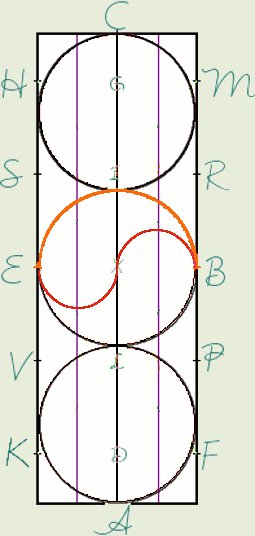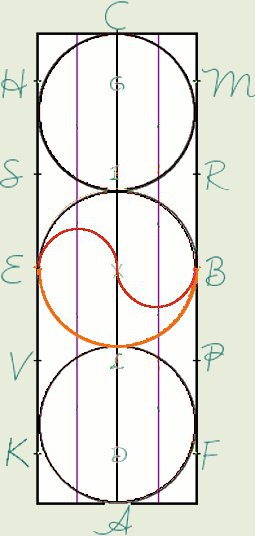Half 20m Canter Circle to Walk S
rinse, repeat
I really love the canter, and I think the horses do,
too. It is very relaxing, very rhythmic, helps
re-establish 'go,' sorts things out. In a word:
settling. Also joyful. really love the canter, and I think the horses do,
too. It is very relaxing, very rhythmic, helps
re-establish 'go,' sorts things out. In a word:
settling. Also joyful.
Today I was playing with one of my favorite exercises
- a half 20m canter circle followed by an S of 2 half 10m
circles at the walk. This gets a lot done and allows
me to do the same thing in the other direction - so I can
stay symmetrical in the work out. (Don't have to
count!)
The half circle part is more to do with how my ring is
built, but it's turned out handy. My ring is slanted, rather than peaked in the middle, so
it's noticeably higher on one side. When I start out horses I have adopted a habit of cantering
from the low side to the high side - figuring it's easier for them and me to canter 'up the
hill.' With young or unbalanced horses, I like to canter out of the
walk because this is also, in my experience, a more settling
transition. It's easier to stay in balance and it
makes sense to the horses. And by the time I get to
the other side of the circle, which is at the top, we're both ready to go
slower again. It helps keep it all short and sweet and
gives them a chance to stay sane.
This week my Progressions were about 'Straightness on the
Circle' and as such the emphasis is more about allowing each
of the vertebra in the horse's spine to 'twirl' the same
amount. The twirling of the vertebra is what produces
what looks like a bend along the horse's spine - and what is
called a 'bend' in the horse world. But anatomically,
it's not a bend.
The bend in the horse's spine is not a bend in the true
sense of the word. It's not like when you take a spaghetti
noodle and hold the ends and bend it. You don't squash
one side of the horse and stretch the other. It's like
when you take a wash cloth and wring the wash cloth and it
ends up being bent. The horse's spine is like that -
like you've taken each end and twisted it along its length,
and as a result of that twisting, you get what horse folks
call a bend. Both sides of the horse are stretched - the one
on the inside of the circle and the one on the outside of
the circle.
 When I'm in this 'Straightness on a Circle' week, I'm attending
to how well the spine of the horse is staying on the path of
the circle and how even the twirls along the spine are. When I'm in this 'Straightness on a Circle' week, I'm attending
to how well the spine of the horse is staying on the path of
the circle and how even the twirls along the spine are.
When horses start out, we might only make it around
half the circle because they're unbalanced or uncoordinated
or unfit or un-whatever. Eventually we get to where
we can do several single circles. Then two circles in
a row several times. Then several circles in a row.
Then we get to where that's all pretty much old hat and we
don't have to do a ton of circles and we're back to half
circles.
Since my horses have been at this awhile, we're back
to half circles. Half of the
20m circle allows for a lot of awareness and then it's time
for a rest -- which is where the S at the walk comes in. So we canter half
the 20m circle and then transition 'at the top' back to the
walk. (I let the transition happen as it will - this is
not a week about transitions, although this is a transition
that I expect to happen pretty well at this time.) From there we twirl more to produce the
first half of the S - a half 10m circle. The 10m
circle is an old hat thing, too.
It's all old hat and yet there is something magical that happens at that
point. They have to reorganize.
And then about the time they figure that out, we twirl
the other way to get the second half of the S - a half 10m circle. And again - there's a magical
moment. Then we're preparing for the new canter lead
and lifting up into it and enjoying that.
The whole thing is very nice.
I was doing this under saddle this morning, but it
can be done with long lines in the ring or round pen or
wherever or in the round pen without the long lines.
If you try it, let me know how it goes! And if
you'd like some hands on, call me up for a
lesson.
Cheers!
L
|




![Centered Riding Today: An Informal Talk by Sally Swift [VHS]](http://ecx.images-amazon.com/images/I/41Vn6PfhzML._SL125_.jpg)
![Centered Riding with Sally Swift [VHS]](http://ecx.images-amazon.com/images/I/51OSh9kd9iL._SL125_.jpg)
 really love the canter, and I think the horses do,
too. It is very relaxing, very rhythmic, helps
re-establish 'go,' sorts things out. In a word:
settling. Also joyful.
really love the canter, and I think the horses do,
too. It is very relaxing, very rhythmic, helps
re-establish 'go,' sorts things out. In a word:
settling. Also joyful. When I'm in this 'Straightness on a Circle' week, I'm attending
to how well the spine of the horse is staying on the path of
the circle and how even the twirls along the spine are.
When I'm in this 'Straightness on a Circle' week, I'm attending
to how well the spine of the horse is staying on the path of
the circle and how even the twirls along the spine are.


